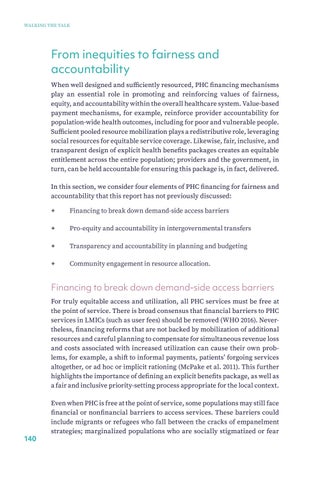WALKING THE TALK
From inequities to fairness and accountability When well designed and sufficiently resourced, PHC financing mechanisms play an essential role in promoting and reinforcing values of fairness, equity, and accountability within the overall healthcare system. Value-based payment mechanisms, for example, reinforce provider accountability for population-wide health outcomes, including for poor and vulnerable people. Sufficient pooled resource mobilization plays a redistributive role, leveraging social resources for equitable service coverage. Likewise, fair, inclusive, and transparent design of explicit health benefits packages creates an equitable entitlement across the entire population; providers and the government, in turn, can be held accountable for ensuring this package is, in fact, delivered. In this section, we consider four elements of PHC financing for fairness and accountability that this report has not previously discussed: ++
Financing to break down demand-side access barriers
++
Pro-equity and accountability in intergovernmental transfers
++
Transparency and accountability in planning and budgeting
++
Community engagement in resource allocation.
Financing to break down demand-side access barriers For truly equitable access and utilization, all PHC services must be free at the point of service. There is broad consensus that financial barriers to PHC services in LMICs (such as user fees) should be removed (WHO 2016). Nevertheless, financing reforms that are not backed by mobilization of additional resources and careful planning to compensate for simultaneous revenue loss and costs associated with increased utilization can cause their own problems, for example, a shift to informal payments, patients’ forgoing services altogether, or ad hoc or implicit rationing (McPake et al. 2011). This further highlights the importance of defining an explicit benefits package, as well as a fair and inclusive priority-setting process appropriate for the local context.
140
Even when PHC is free at the point of service, some populations may still face financial or nonfinancial barriers to access services. These barriers could include migrants or refugees who fall between the cracks of empanelment strategies; marginalized populations who are socially stigmatized or fear


